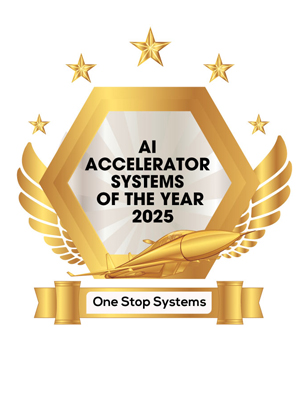THANK YOU FOR SUBSCRIBING
 Mike Knowles, President and CEO
Mike Knowles, President and CEOOne Stop Systems (OSS) fills this requirement, delivering data center-level performance with the rugged reliability needed for mission-critical and industrial applications. With a focus on defense and commercial markets, it redefines computing at the edge.
“We equip edge users with ultra-low-latency, high-performance computing and data center-level storage capabilities, ensuring powerful AI processing even in the most unforgiving environments where failure is not an option,” says Mike Knowles, president and CEO.
This is particularly beneficial in the defense sector, especially with drones, tanks and submarines, requiring real-time sensor fusion, AI/ML processing, autonomy and mission-critical data analysis all essential for tactical decision-making. On the commercial side, OSS brings the same high-performance AI and autonomous processing to industries such as trucking, motorsports, aerospace and agriculture, enabling smarter and more efficient operations.
Data Center Processing in Embedded Computing Form Factor
As the complexity of AI-driven applications at the edge steadily outgrows traditional embedded systems, OSS keeps pace with AI performance demands beyond basic processing needs. Today, nearly every sensor requires AI—and, in many cases, multiple AI inferences at each sensor node. Since standard embedded technology cannot accommodate this computing demand, the OSS approach provides the required real-time, low-latency decision-making ability while adhering to the size, weight, and power (SWaP) constraints.
-
We equip edge users with ultra-low-latency, high-performance computing and data center-level storage capabilities, ensuring powerful AI processing even in the most unforgiving environments where failure is not an option
This results from balancing two ends of the industry spectrum—companies specializing in rugged embedded systems, while others focus on high-performance computing. By merging their strengths, OSS delivers solutions that combine the durability of embedded systems with the raw power of GPUs, all while optimizing SWaP. The company has followed this approach in defense and commercial AI applications with scalable products like AIready servers, storage systems and high-speed switch fabrics to connect multiple GPUs. It uses the range of available GPUs to customize solutions for each client’s specific needs, ensuring sufficient computing capabilities at the edge.
The OSS Impact
One Stop Systems (OSS) is redefining what’s possible in edge computing by delivering data center-level performance in ruggedized, SWaP-optimized systems. This capability is not theoretical—it’s proven in mission-critical deployments.
For instance, OSS enabled the U.S. Army to achieve 360-degree situational awareness in combat vehicles by integrating multiple video feeds into the crew station. This advanced system, built with scalable GPU processing and PCIe switch fabrics in a rugged form factor, dramatically outperformed its predecessor.
In another case, OSS supported the U.S. Navy’s P-8 Poseidon maritime patrol aircraft with a high-performance solution to store and process vast volumes of sensor data. OSS’s airborne data processing approach cut post-mission analysis time from hours to just minutes—advancement validated and embraced by the Navy.
These innovations underscore OSS’s growing influence across domains like electronic warfare, sonar, and radar signal processing. As AI-driven applications continue to demand ever more compute at the edge, OSS remains at the forefront— enhancing its software stack and hardware portfolio to deliver the reliability, power, and real-time responsiveness that modern defense and industrial missions require.
| Share this Article: |
One Stop Systems
Company
One Stop Systems
Management
Mike Knowles, President and CEO
Description
One Stop Systems, a small business focused on defense and commercial markets, merges data center-like capabilities and the ruggedness associated with embedded systems to provide powerful yet durable computing solutions to end users at the edge. The edge can be trains, ships, drones, tanks, submarines, and other platforms.






